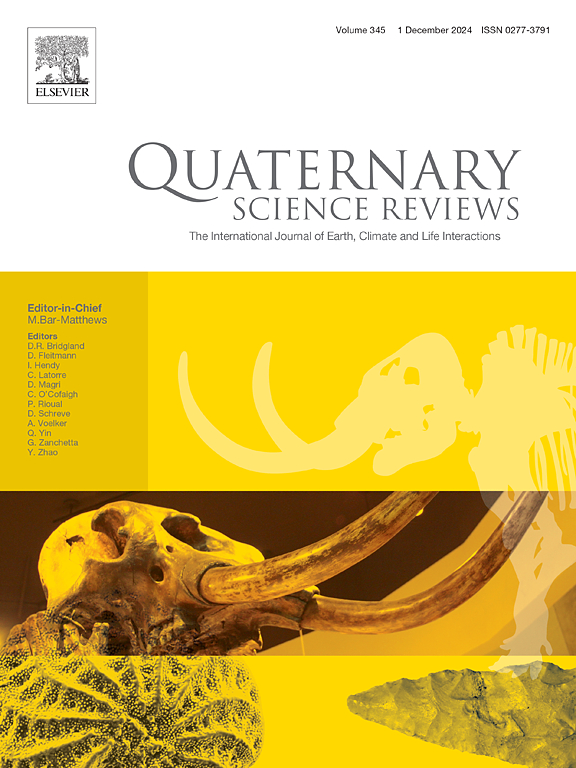A millennial record of lake ecosystem responses to climatic variability in the Yellow River Source Area
IF 3.2
1区 地球科学
Q1 GEOGRAPHY, PHYSICAL
引用次数: 0
Abstract
The Yellow River Source Area (YRSA), a key habitat for protected wild animals and an ecological security barrier in northern China, is crucial for biodiversity and downstream welfare. Climate warming has significantly degraded the YRSA ecological environment. However, owing to a lack of monitoring records, little is known about how freshwater lake ecosystems respond to climatic variability. In this study, we investigated the long-term hydroclimatic changes and diatom community evolution in Gyaring Lake, the second largest lake in the YRSA, by analyzing the total organic carbon (TOC), biogenic silica (BSi), authigenic carbonate δ18O and fossil diatoms in a sedimentary core (ZLH2) that was radiocarbon-dated (14C). Our results indicated that the YRSA hydroclimate transformed from warm–dry conditions during the Medieval Warm Period (MWP) to cold–wet during the Little Ice Age (LIA). The ensuing ecological effects include a shift in dominant diatom species from benthic to periphytic taxa, which may reflect an extension and diversification of micro-habitats. Despite the significant linear relationship between diatom biomass and hydroclimate over the past millennium, the response of diatom diversity to climate change appears to be more complex, showing a nonlinear relationship. The divergence in seasonal temperature records and alterations in habitat corresponded with the variations in diatom biomass and diversity, suggesting that the length of the growing season and habitat are crucial for freshwater ecosystem biodiversity in the YRSA. In summary, our research provides biostratigraphical evidence of the impact of climatic variability on lake biota and reveals a nonlinear pattern of freshwater ecosystem responses to climate on the Qinghai–Tibetan Plateau (QTP).
黄河源区湖泊生态系统对气候变化响应的千年记录
黄河源区是中国北方重要的野生保护动物栖息地和生态安全屏障,对生物多样性和下游福祉至关重要。气候变暖导致长江流域生态环境明显恶化。然而,由于缺乏监测记录,人们对淡水湖生态系统如何对气候变化作出反应知之甚少。利用放射性碳定年(14C)沉积岩心(ZLH2)中总有机碳(TOC)、生物源硅(BSi)、自生碳酸盐δ18O和硅藻化石,研究了gyarga第二大湖泊甲陵湖的长期水文气候变化和硅藻群落演化。结果表明,该地区的水文气候由中世纪暖期(MWP)的暖干气候向小冰期(LIA)的冷湿气候转变。随之而来的生态效应包括优势硅藻种类从底栖植物类群向周围植物类群的转变,这可能反映了微生境的扩展和多样化。尽管过去千年硅藻生物量与水文气候之间存在显著的线性关系,但硅藻多样性对气候变化的响应似乎更为复杂,呈现出非线性关系。季节温度记录的差异和栖息地的变化与硅藻生物量和多样性的变化相对应,表明生长季节和栖息地的长度对长江三角洲淡水生态系统的生物多样性至关重要。总之,本研究为气候变化对湖泊生物区系的影响提供了生物地层学证据,揭示了青藏高原淡水生态系统对气候响应的非线性模式。
本文章由计算机程序翻译,如有差异,请以英文原文为准。
求助全文
约1分钟内获得全文
求助全文
来源期刊

Quaternary Science Reviews
地学-地球科学综合
CiteScore
7.50
自引率
15.00%
发文量
388
审稿时长
3 months
期刊介绍:
Quaternary Science Reviews caters for all aspects of Quaternary science, and includes, for example, geology, geomorphology, geography, archaeology, soil science, palaeobotany, palaeontology, palaeoclimatology and the full range of applicable dating methods. The dividing line between what constitutes the review paper and one which contains new original data is not easy to establish, so QSR also publishes papers with new data especially if these perform a review function. All the Quaternary sciences are changing rapidly and subject to re-evaluation as the pace of discovery quickens; thus the diverse but comprehensive role of Quaternary Science Reviews keeps readers abreast of the wider issues relating to new developments in the field.
 求助内容:
求助内容: 应助结果提醒方式:
应助结果提醒方式:


